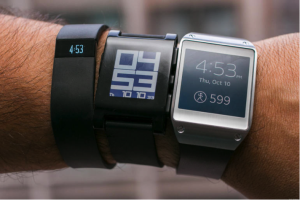Fitness tracker or a smartwatch? Well, that’s a question that was asked a couple of years ago, but plainly put to rest over the last 2 years. Utility and price point have been the two determining factors when it comes to wearable adoption. Fitness trackers have outsold smartwatches by more than 3:1 over the last couple of years and since the wearable market took shape in the mainstream consumer market.
Fitness trackers are simpler to use than smartwatches and can stand alone with code, logic, sensors and relays within their encasements. Smartwatches are quite cumbersome, lacking for battery life, require a host operating system (OS), attempt and fail at duplicating the major utility of a smartphone and at a great expense to the consumer. With all of these shortcomings on the part of the smartwatch, it is easy to argue in favor of fitness trackers and that is even without recognizing the evolution-fitness trackers have undertaken in recent quarters.

Fitbit (FIT ) is the leading global wearable company with roughly 26.8% market share. A distant second and third to Fitbit in terms of market share are the Chinese conglomerate Xiaomi at 14.7% and Apple Inc. (AAPL) at 14.2 percent. Apple’s decision to focus only on the smartwatch segment of the wearables market has impacted their ability to increase their market share. Moreover, the company relies on its user base to account for nearly all of its smartwatch sales, as the Apple Watch products are only compatible with iOS and require an operating iPhone unit. These issues have also plagued Samsung regarding its market share and sales of its smartwatch, the Gear and iterations of the Gear. Samsung has only a 3.9% global market share of the wearables market. Having said that, Samsung grew its global smartwatch shipments by over 38% in the 2017 period. The difference in market share versus shipments demonstrates that smartwatches are literally sitting on retail shelves and consumers simply aren’t buying them to any significant degree and certainly no where near the rate they are purchasing fitness trackers. It’s been rather easy for smartwatch manufactures to sell their product to retailers, but extremely difficult for the retailers to sell them to consumers. It’s also why smartwatches continue to be discounted even after the holiday shopping season. I offered such commentary as it pertained to Apple’s over-hyped smartwatch sales during the most recent Q4 2016 Holiday sales period in an article titled Fitbit Retrenches: The Bottoming Phase For A Hardware Company.
For all intended purposes, the smartwatch has been a colossal failure as sales in the category have fallen precipitously YOY. In fact, the only time smartwatches, as a category, grow sales is when a new product launches in conjunction with a previous product shipment. For example: Apple (AAPL) has touted the Q4 2016 period as having shown its greatest sales for the Apple Watch. Mind you, the company has made absolutely no mention of the profitability of the Apple Watch, the average selling price (ASP) or sell-through statistics…and why would they? Here is what really happened with the Apple Watch Series 1 and 2 during the holiday period. In 2015, Apple only had one Apple Watch for which sales were so poor the company reduced the price nearly a year before the company released a new iteration. This hasn’t happened with an Apple product since the company launched the iPod product line. In Q4 2016, the company had two versions of the Apple Watch it sold-in to retailers, a sky increase of 100 percent. Apple only reports sell-in metrics per SEC regulations, like Fitbit. So as one can see, the sku count for the Apple Watch increased 100% YOY, thus boosting sales for the Apple Watch. But the sell-through, meaning from the retailer to the consumer, has been paltry. It’s why the consumer could find door buster deals on the Apple Watch Series 1 for $199 on Black Friday. Truth be told, that door buster became the ASP for the Apple Watch throughout the December period. Truth be told, that sale price is still being offered at various retailers every month since. Truth be told again, that’s why Apple’s CEO, Tim Cook, won’t discuss the ASP or the sell-through of the Apple Watch. Hard not to grow sales for the Watch when you are offering two Apple Watches in 2016; a 100% increase in sku count YOY.












Leave A Comment